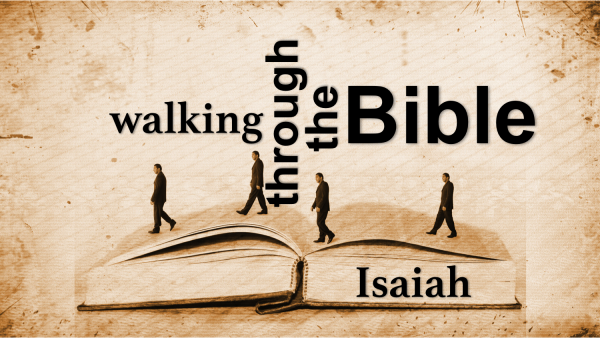Isaiah, the writer, identifies self and time of service in verse one: “The vision of Isaiah the son of Amoz which he saw concerning Judah and Jerusalem in the days of Uzziah, Jotham, Ahaz, and Hezekieh, kings of Judah” (Isaiah 1:1). History, then, would place the prophetic work of Isaiah from 759-698 B.C. At this same time Micah was also prophesying in Judah and Amos and Hosea were working in Israel. As is evident, Isaiah was working prior to the captivities of both Israel and Judah, but these nations were already walking the spiritual road that would lead them to exile. What is likewise evident then would be the focus of Isaiah’s work, and that was trying to get the people to repent so as to avoid the consequences that would surely come. The spiritual state of Judah at the time is well determined by Isaiah’s proclamation on the sinful nation:
“Ah sinful nation, a people laden with iniquity, a seed of evildoers, children that are corrupters: theyhave forsaken the LORD, they have provoked the Holy One of Israel unto anger, they are gone away backward. Why should ye be stricken any more? ye will revolt more and more: the whole head is sick, and the whole heart faint. From the sole of the foot even unto the head there is no soundness in it; but wounds, and bruises, and putrifying sores: they have not been closed, neither bound up, neither mollified with ointment. Your country is desolate, your cities are burned with fire: your land, strangers devour it in your presence, and it is desolate, as overthrown by strangers. And the daughter of Zion is left as a cottage in a vineyard, as a lodge in a garden of cucumbers, as a besieged city. Except the LORD of hosts had left unto us a very small remnant, we should have been as Sodom, and we should have been like unto Gomorrah” (Isaiah 1:4-9).
This written prophecy is often depicted as the “miniature Bible” because of its arrangement and focus. Dunn said regarding this:
“It has 66 chapters with two main divisions of 39 and 27 chapters. The first division, like the 39 books of the Old Testament, emphasize God’s judgment upon immoral and idolatrous men. The last part presents the grace of God in the promise of the redeemer, concluding with the final judgment. Like the 27 books of the New Testament, these chapters declare a message of hope in the promise of a Redeemer “to bear a cross and wear a crown.”
It is from the two sections, one from each, that the book of Isaiah provides two of the most widely known and significant passages in all of the Bible. First, in Isaiah 2:2-3 there is found a great prophecy and description of the coming kingdom:
“And it shall come to pass in the last days, that the mountain of the Lord’s house shall be established in the top of the mountains, and shall be exalted above the hills; and all nations shall flow unto it. And many people shall go and say, Come ye, and let us go up to the mountain of the Lord, to the house of the God of Jacob; and he will teach us of his ways, and we will walk in his paths: for out of Zion shall go forth the law, and the word of the Lord from Jerusalem.”
Deliverance would eventually come to Jerusalem, but the people are warned that it would come in the last days (final dispensation of time) when the crowning achievement of the Lord would be established in Jerusalem which would be exalted to the heavens and would be open and accepting of all nationalities. Many would seek the kingdom in which they knew the law of the Lord would be made known to them and would then spread forth to all nations under heaven. This prophecy, among others, allows New Testament Christians today to identify what the true church of the Bible was to be, based upon general characteristics of it. To the Jews it was hope to come, but to men today it is hope realized in looking forward to the salvation that awaits that church (Ephesians 1:22-23).
From the second section there is the record of the Suffering Servant to come. Isaiah 53 is a marvelous passage that should instill appreciation and gratitude in the hearts of all Christians for they have enjoyed the benefits of this suffering. Obviously a picture of Christ, He is previewed as the Man of sorrows, the Lamb to the slaughter, and the Offering for sin. For the good of all mankind, “Surely he hath borne our griefs, and carried our sorrows: yet we did esteem him sticken, smitten of God, and afflicted. But he was wounded for our transgressions, he was bruised for our iniquities: the chastisement of our peace was upon him; and with his stripes we are healed” (Isaiah 53:4-5).
A final marvel to be considered from Isaiah’s prophecy is just that, his prophecies of the coming Messiah. Of the 333 prophecies in the Old Testament of the coming Messiah, a number of them are clearly pictured in Isaiah. Wilkinson and Boa mention just a few with their fulfillments:
“7:14 (Matthew 1:22-23); 9:1-2 (Matthew 4:12-16); 9:6 (Luke 2:11; Ephesians 2:14-18); 11:1 (Luke 3:23,32; Acts 13:22-23); 11:2 (Luke 3:22); 28:16 (I Peter 2:4-6); 40:3-5 (Matthew 3:1-3); 42:1-4 (Matthew 12:15-21); 42:6 (Luke 2:29-32); 50:6 (Matthew 26:67; 27:26,30); 52:14 (Philippians 2:7-11); 53:3 (Luke 23:18; John 1:11; 7:5); 53:4-5 (Romans 5:6,8); 53:7 (Matthew 27:12-14; John 1:29; I Peter 1:18-19); 53:9 (Matthew 27:57-60); 53:12 (Mark 15:28); 61:1 (Luke 4:17-19,21).”
To Isaiah and the Holy Spirit who inspired him, man owes a debt of gratitude. It is through his written work perhaps more than any other’s that we are able to look forward with hope to “Comfort ye, comfort ye my people, saith your God” (Isaiah 40:1).

